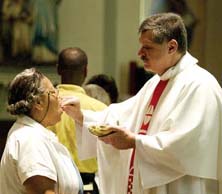
As a family nurse practitioner and an inner city parish priest in Brooklyn, New York, I came to Johns Hopkins School of Nursing in search of an answer to violence.
In my work in a small clinic sponsored by the Catholic diocese of Brooklyn, on Sutter Avenue in East New York, I witnessed the effects of violence on a daily basis — teenagers and even children caught in gun crossfire, severe child abuse, and domestic violence on many levels. Most medical diagnoses were secondary to violence.
Once I finished for the day at the clinic, I would head home to the rectory and check the roster to see what my priestly duties were for the week. As a Catholic priest in a Franciscan order, those duties included overseeing funerals, attending wakes, and making hospital visits. It was not unusual for me to preside at the funerals of parishioners half my age, victims of a seemingly endless cycle of violence.
It did not take me long to realize that violence was the common variable intruding on the spiritual and physical health of my patients. A few years ago, for example, a 30-year-old single mother of five, whom I will call Tanya, came to see me. She would bring her children to the clinic for primary care, and I began to notice a psycho-social change in her with each visit. Her mood was flat, she was short-tempered with her children, and an overall sadness pervaded her spirit. Gently, I asked questions and more questions only to discover that the change in Tanya was due to domestic violence. The perpetrator was her 16-year-old son.
It was my experience with Tanya that brought me to the School of Nursing doctoral program. I wanted to develop the skills to investigate violence and its relationship to health. Shortly after I arrived at Hopkins, I heard the dean at the time, Dr. Sue Donaldson, advocating the need to realize nursing as a practice-oriented profession. She and other nurse researchers at Hopkins make it clear that nursing research is not just about answering a question, but it must also consider how the answer will play out in the lives of people. Another advantage to being at Johns Hopkins is the available collaboration with peers and faculty from the Bloomberg School of Public Health. Partnering with others in research gives yet another insight to the violence phenomena.
As a doctoral student, I was originally interested in the effects of chronic domestic violence on children, but now my focus has shifted. In the litany of questions generated by the research of others, and the blending of my life as a priest with my nursing, I concentrate now on dating couples. In the required Roman Catholic preparation for marriage, there is no screening for violence between partners — something I find surprising. Through my research so far on interpersonal violence, I have learned that domestic violence does not begin after the “I do’s” have been said. It almost always manifests itself during the courtship phase. In addition, I have seen how spirituality can play a healing role in patient care. So what part does spirituality play for the person who experiences violence within courtship? I don’t know the answer to that yet, but a pressing question for me remains: Can spirituality be a resource in breaking this cycle of violence?
The more I seek to find answers to my questions, the more questions I ask. I look forward to completing my doctoral degree and becoming an educated nurse sensitized to the variety of research for nursing practice, not only in the area of domestic violence but in our profession as a whole.
— Rev. Ed Polichnowski, PhD candidate